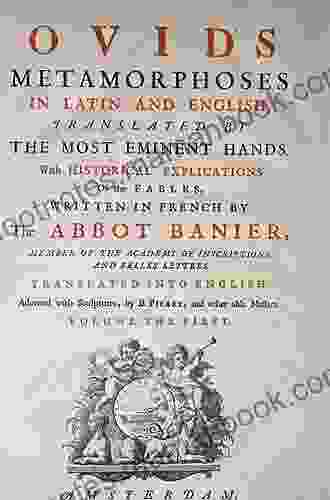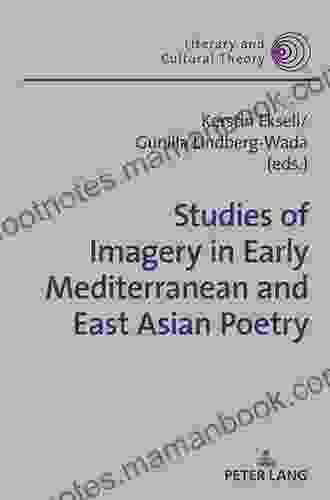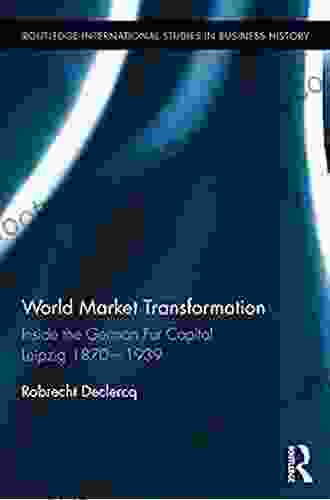Studies of Imagery in Early Mediterranean and East Asian Poetry: Literary and Cultural Confluences

The study of imagery in poetry has long been a central concern of literary scholars, and for good reason: imagery is one of the most powerful tools that poets have at their disposal for creating vivid and memorable scenes, expressing complex emotions, and conveying profound ideas. In recent years, there has been growing interest in the comparative study of imagery in different cultural traditions, and this article will explore some of the ways in which imagery has been used in early Mediterranean and East Asian poetry.
5 out of 5
| Language | : | English |
| File size | : | 2438 KB |
| Text-to-Speech | : | Enabled |
| Screen Reader | : | Supported |
| Enhanced typesetting | : | Enabled |
| Print length | : | 300 pages |
Mediterranean Poetry
The earliest known examples of Mediterranean poetry come from the ancient Near East, where poets such as Enheduanna and Gilgamesh used vivid imagery to describe the natural world, the gods, and the human condition. These early poems often employed metaphor and simile to create striking and memorable images, and they frequently used repetition and parallelism to reinforce their messages. For example, in the following excerpt from the Epic of Gilgamesh, the hero's friend Enkidu describes the beauty of the goddess Ishtar:
"Her eyes are like lapis lazuli, Her hair is like spun gold, Her body is like ivory, Her skin is like alabaster, Her lips are like honey."
This passage uses a series of vivid images to create a striking portrait of Ishtar. The poet's use of metaphor and simile helps to convey the goddess's beauty and power, and the repetition and parallelism of the lines helps to create a sense of rhythm and incantation.
In addition to metaphor and simile, Mediterranean poets also frequently used personification to create vivid and memorable images. For example, in the following excerpt from the Iliad, the poet Homer personifies the river Scamander as a god who is angry with the Greeks:
"But the god Scamander, swelled with rage, Rose from his bed, and roared as loud as ten thousand men, And smote the Greeks with fury."
By personifying the river Scamander, Homer creates a vivid and powerful image of the river's destructive force. The poet's use of hyperbole also helps to convey the magnitude of the river's anger, and the alliteration in the line "But the god Scamander, swelled with rage" helps to create a sense of rhythm and movement.
East Asian Poetry
The earliest known examples of East Asian poetry come from China, where poets such as Qu Yuan and Li Po used vivid imagery to express their feelings about nature, love, and loss. These early poems often employed symbolism and allusion to create complex and evocative images, and they frequently used understatement and suggestion to convey their messages. For example, in the following excerpt from the poem "Li Sao" by Qu Yuan, the poet uses symbolism to describe his feelings of exile:
"I wander in a wilderness of thorns, And gather bitter herbs to eat. I drink the dew from the leaves of trees, And hunger for the fruits of autumn."
This passage uses a series of vivid images to create a stark and desolate portrait of the poet's exile. The thorns and bitter herbs symbolize the hardships that the poet has endured, and the dew and autumn fruits symbolize the things that he has lost. The poet's use of understatement and suggestion also helps to convey a sense of longing and regret.
In addition to symbolism and allusion, East Asian poets also frequently used parallelism and repetition to create vivid and memorable images. For example, in the following excerpt from the poem "The Peach Blossom Spring" by Tao Yuanming, the poet uses parallelism to describe the beauty of the peach blossom spring:
"The peach blossoms are in full bloom, And the petals are like the rosy clouds of dawn. The trees are laden with fruit, And the birds are singing in the branches."
This passage uses a series of parallel lines to create a vivid and charming portrait of the peach blossom spring. The poet's use of repetition also helps to create a sense of rhythm and incantation.
Literary and Cultural Confluences
The study of imagery in early Mediterranean and East Asian poetry reveals a number of interesting literary and cultural confluences. For example, both Mediterranean and East Asian poets frequently used metaphor, simile, and personification to create vivid and memorable images. They also both employed symbolism and allusion to create complex and evocative images, and they frequently used understatement and suggestion to convey their messages.
In addition to these shared literary devices, Mediterranean and East Asian poetry also share a number of common themes. For example, both Mediterranean and East Asian poets frequently wrote about nature, love, and loss. They also both explored the themes of exile, wandering, and the search for home. These common themes suggest that, despite their different cultural origins, Mediterranean and East Asian poets were grappling with the same fundamental human experiences.
The study of imagery in early Mediterranean and East Asian poetry also reveals a number of interesting cultural differences. For example, Mediterranean poets tended to use more vivid and explicit imagery than East Asian poets. They also tended to be more direct in their expression of emotions. East Asian poets, on the other hand, tended to use more subtle and suggestive imagery. They also tended to be more restrained in their expression of emotions.
These cultural differences are likely due to a number of factors, including the different cultural values and beliefs of the two regions. In the Mediterranean region, for example, there was a strong emphasis on individualism and self-expression. This emphasis is reflected in the poetry of the region, which is often characterized by its vivid and explicit imagery. In East Asia, on the other hand, there was a strong emphasis on harmony and collectivism. This emphasis is reflected in the poetry of the region, which is often characterized by its subtle and suggestive imagery.
The study of imagery in early Mediterranean and East Asian poetry reveals a number of interesting literary and cultural confluences and differences. Both Mediterranean and East Asian poets used vivid and evocative imagery to create powerful and memorable
5 out of 5
| Language | : | English |
| File size | : | 2438 KB |
| Text-to-Speech | : | Enabled |
| Screen Reader | : | Supported |
| Enhanced typesetting | : | Enabled |
| Print length | : | 300 pages |
Do you want to contribute by writing guest posts on this blog?
Please contact us and send us a resume of previous articles that you have written.
 Top Book
Top Book Novel
Novel Fiction
Fiction Nonfiction
Nonfiction Literature
Literature Paperback
Paperback Hardcover
Hardcover E-book
E-book Audiobook
Audiobook Bestseller
Bestseller Classic
Classic Mystery
Mystery Thriller
Thriller Romance
Romance Fantasy
Fantasy Science Fiction
Science Fiction Biography
Biography Memoir
Memoir Autobiography
Autobiography Poetry
Poetry Drama
Drama Historical Fiction
Historical Fiction Self-help
Self-help Young Adult
Young Adult Childrens Books
Childrens Books Graphic Novel
Graphic Novel Anthology
Anthology Series
Series Encyclopedia
Encyclopedia Reference
Reference Guidebook
Guidebook Textbook
Textbook Workbook
Workbook Journal
Journal Diary
Diary Manuscript
Manuscript Folio
Folio Pulp Fiction
Pulp Fiction Short Stories
Short Stories Fairy Tales
Fairy Tales Fables
Fables Mythology
Mythology Philosophy
Philosophy Religion
Religion Spirituality
Spirituality Essays
Essays Critique
Critique Commentary
Commentary Glossary
Glossary Bibliography
Bibliography Index
Index Table of Contents
Table of Contents Preface
Preface Introduction
Introduction Foreword
Foreword Afterword
Afterword Appendices
Appendices Annotations
Annotations Footnotes
Footnotes Epilogue
Epilogue Prologue
Prologue Susan R Grayzel
Susan R Grayzel John Haysom
John Haysom Dane Huckelbridge
Dane Huckelbridge Frank Erickson
Frank Erickson Matthew Mather
Matthew Mather Tom Henry
Tom Henry Terry L Duran
Terry L Duran J Sharpe
J Sharpe Patricia Gardner
Patricia Gardner Imran Ahmad A
Imran Ahmad A Mark Owens
Mark Owens Linda Robinson
Linda Robinson Miguel Angel Gardetti
Miguel Angel Gardetti Jack Smith
Jack Smith Jim Barrow
Jim Barrow Carl Menger
Carl Menger Matthew Thorburn
Matthew Thorburn Nick Petrie
Nick Petrie Brad Johnson
Brad Johnson Poppy Dodson
Poppy Dodson
Light bulbAdvertise smarter! Our strategic ad space ensures maximum exposure. Reserve your spot today!
 Jeffrey CoxFollow ·11.4k
Jeffrey CoxFollow ·11.4k William PowellFollow ·2.1k
William PowellFollow ·2.1k Robert Louis StevensonFollow ·7.3k
Robert Louis StevensonFollow ·7.3k Clinton ReedFollow ·17.3k
Clinton ReedFollow ·17.3k Dallas TurnerFollow ·4.8k
Dallas TurnerFollow ·4.8k Clark CampbellFollow ·8.9k
Clark CampbellFollow ·8.9k Rick NelsonFollow ·14k
Rick NelsonFollow ·14k Charles BukowskiFollow ·10.7k
Charles BukowskiFollow ·10.7k

 Colin Foster
Colin FosterBlacktop Wasteland: A Novel S A Cosby
In the vast literary landscape of...

 Curtis Stewart
Curtis StewartOvid's Metamorphoses: An Ancient Epic of Transformation...
Ovid's Metamorphoses is an epic poem...

 Adam Hayes
Adam HayesThe Elements of Piano Playing Op. 30: A Comprehensive...
: Unveiling...

 Patrick Hayes
Patrick HayesLee Marvin and The Long Night: A Tale of Vengeance, Grit,...
In the annals of Western cinema, few...

 Jermaine Powell
Jermaine PowellUnveiling the Alluring World of Romantic Thrillers,...
Prepare to delve into a...
5 out of 5
| Language | : | English |
| File size | : | 2438 KB |
| Text-to-Speech | : | Enabled |
| Screen Reader | : | Supported |
| Enhanced typesetting | : | Enabled |
| Print length | : | 300 pages |














